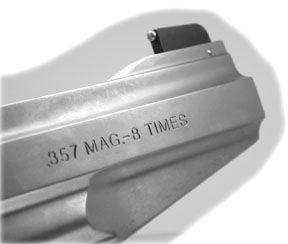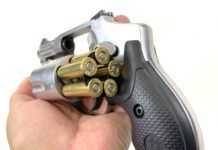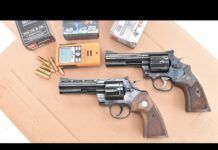
The words high-capacity and revolver are not often used in the same sentence. However, eight-shot revolvers have been on the scene for a number of years now, and the list is quietly, almost secretly, growing. In the last year, Smith & Wesson has released two new models, one in .38 Super and another blued-steel model with old-fashioned (nee, classic), two-piece wooden grips, to replace the Model 27. In this test, however, we’ll focus on the two revolvers that started it all, the Taurus 608 and the S&W 627PC.
Anyone writing the history of the modern — or rather, post-modern — high-capacity revolver should probably not fail to mention two important names, John J. Baumann and Charles Prest. By the time a group of hard-core revolver shooters led by Michael and Sharon Higashi had formed ICORE (the International Confederation of Revolver Enthusiasts) some years back, the hot setup was to have a “Baumann-ized” revolver. This meant sending your large N-frame Smith and Wesson to John Baumann, a machinist located in New York, to be fitted with a seven-shot cylinder and timing to match. Jerry Miculek won several championships with one of Baumann’s modified revolvers.
Some time later, Charlie Prest began producing eight-shot revolvers chambered for .38 Super. Prest’s RPM shop donated one such model to be awarded as top prize at the International Revolver Championship in 1995. Jerry Miculek won the gun, and with it, made history. In 1996 Jerry topped the formerly unbeatable Jethro Dionisio for High Overall at the American Handgunner World Shootoff. Dionisio, shooting a semiauto built by Johnny Lim, lost to Miculek in one of the most exciting man-on-man shootoffs ever. This was the first — and only — time a revolver shooter won a major speed-shooting match.
Will either the Taurus 608 or the S&W 627PC make you a world-beater? Yes, if you shoot against lowly six-shooters. In the meantime let’s take a look at what makes these two revolvers so special, and perhaps find out which one is better for you.
Taurus 608, $465
In reviewing the specifications of this revolver one characteristic stuck out. The Taurus 608 was a big gun. The 608-series pre-dates Taurus’s release of the Raging Bull, but even though the 608 is built on a smaller frame, you can see where the original “Bull” got its design. The 6.5-inch barrel was ballasted by a full lug. The top of the barrel included a vent-rib section approximately 4 inches in length, with a stanchion-based ramp front sight. Serrations starting at the base of the stanchion continued to the very top, where they met an orange plastic insert. The visual field on this ramp was a full inch long.
Adjacent to the front sight were eight ports that bled gas pressure from an unrifled expansion chamber within the barrel. The gas of the burning powder flowed from the chamber out the ports to give a downward force to the muzzle. While the overall length of the barrel was listed as 6.5 inches, only 5.5 inches of rifling applied rotation to the bullet. A welcome by-product of this design was that the crown of the barrel was well protected.
The barrel appeared to have a very high twist rate. The 608 is very muzzle-heavy, so, with the help of the porting, there aren’t many cartridges that are going to abuse you with recoil. In fact, Federal’s over-1,600 fps, 130-grain Hydra-Shok load that normally gives very harsh recoil was merely “entertaining,” as one shooter put it. This assessment of the Hydra-Shok was a little like referring to a Doberman pinscher as “cute.”
Taurus and S&W have been going back and forth with design ideas from the beginning, but lately only in smaller details. One such detail carried over from S&W to Taurus is the cylinder latch, which is now scalloped to allow for quicker loading. The S&W 627 came from the factory with full-moon clips and the proper machining to make use of them, but the Taurus was not cut for use with clips. An aftermarket conversion to clips is available from Clark Custom Guns in Princeton, Louisiana (toll-free 888 458-4126).
Other upgrades in the Taurus 608 since its release in 1995 included a non-weight-bearing ejector rod; crane detent pin; and key-operated hammer lock. As with all Taurus revolvers manufactured to date, the hammer spring was of coil design.
The 6.5-inch model we tested had a distinct muzzle-heavy feel favored by action shooters who play games such as knocking down bowling pins. A 4-inch model is also available, and we think it would be more suitable for carry or home protection. Our big 608 proved a hair more accurate than the S&W, with an overall average of five-shot groups measuring 2.0 inches, compared to the 627PC’s 2.1.
[PDFCAP(2)]The 627PC did, however, shoot the smallest average group with the Federal Hydra-Shok ammunition, and also did well with the .38 Special Federal 130-grain FMJ. Velocity for the longer 608 was predictably higher from the longer barrel, but a difference in excess of 100 fps was more than we would have expected. In our test sequence we started out by playing indoors with the latest laser system from BeamHit, (800) 232-6448, as we waited for stormy weather to pass.
It was during this session and later verified by live fire that we found each of these guns gave better apparent accuracy when fired double action. One tester theorized that it may be one’s personal orientation, or that the double-action hold gave better recoil control, combined with a sensation of more control over the sights throughout the DA press. We felt that we could also maintain more consistent elevation. Recoil seemed to be more of a factor when firing the S&W due to its lighter, tapered underlug.
In single-action firing, the Taurus felt a little bit “notchy.” The double-action trigger of the Taurus felt like a typical coil-spring mechanism. This meant a smooth take-up to a stacking point, followed by a sudden break. We felt that the Taurus exhibited more “torque-over,” in that we were more aware of the starting and especially the stopping of the rotation of the cylinder by the action of the trigger. Despite an obvious difference in feel, the trigger pulls of both revolvers were comparable in both SA and DA modes as measured by our Chatillon 25-pound trigger gauge ($96.45 Brownells, 1-800-741-0015; part number 174-025-250).
It used to be that if you wanted or needed more than six shots you had to learn to deal with the intricacies of a semiautomatic pistol. Now, the 608 revolver series from Taurus offers simple, formidable and inexpensive firepower.
Smith & Wesson Model 627PC, $975
“PC” stands for Performance Center, which is the specialty shop of S&W. When this model was first introduced it was available through only one Performance Center authorized distributor. Recently the 627PC has become available to all S&W dealers. The Performance Center is a low-volume shop staffed by technicians who take extra time to hand-fit parts. This is one reason why PC guns are more expensive.
The fit and finish of the 627PC was well above average. For example, lockup of the cylinder was extremely solid and precise. Fore and aft movement of the closed cylinder was nil. The front sight was a Patridge blade with gold bead for quick reference. The front blade was pinned in place, but easily interchangeable with other profiles. However, the standard blade would be our first choice.
The fully adjustable rear sight could be easily removed to reveal drilled and tapped holes for a scope mount. The face of the rear sight was serrated to resist glare. This was Smith’s standard rear sight, which has worked so well over the years that early custom gunsmiths such as Armand Swenson adapted it to the 1911 pistol at a time when alternative parts were rare.
An integral, key-operated, trigger lock has been added. The keyhole was directly above the cylinder release, and when the gun was locked, a flag that read “Locked” rose next to the hammer. Until recently the 627s came with a two-piece wooden grip, but ours arrived with the Hogue Mono-grip. In the past, most shooters changed the fancy-wood grips for something that was more personal, and many shooters felt the Hogue Monogrip was hard to beat. The Hogue, like the lock and the rear sight, are standard equipment on almost all S&W revolvers, so one might well wonder how this gun got to be so expensive.
Most of the extra cost of the PC guns is likely in labor and fitting. Skilled workmanship is very expensive today. If we were told the quality of fit or even the steel was better, and the finishing process more time-consuming and thus more costly than standard models, we’d believe it. The additional cuts in the barrel shroud alone are an example of excellent custom work.
The 627PC can be fired with or without the three supplied moonclips. (Extras are available from Brownells, or TKCustom at $35 per 10 clips). This is because unlike the S&W 625 series revolver, which is chambered in .45 ACP, the star of the 627PC acts directly on the rim of the .38/.357 cases instead of just pushing on the clip. Going a little way towards equalizing the price between the Taurus and S&W eight-shooters, converting the Taurus to moonclips would cost an additional $80 as done by Clark Custom Guns, plus two-way overnight shipping.
Originally, neither the 608 nor the 627PC came with a spring-detent system at the crane. Taurus now offers one as standard equipment and S&W does, too. Many serious shooters who bought earlier models of either gun added a ball detent to the top face of the crane, but S&W has found a new way to tackle the problem. Our test gun boasted an oversize, heavily sprung, ball detent in the front face of the crane that acted parallel with the ejector rod. S&W chose to mount the detent in the front face of the crane because there was enough metal available there for a solid mount. Taurus uses a peg for detent instead of a ball because it takes up less room and can fit into the limited available space atop the crane. The ejector rod on both guns was free floating, without the burden of locking up the cylinder from the front.
A comparison of handling gave us the feeling that the 627PC was more practical than the Taurus. Granted, a 4-inch 608 would steer faster and weigh less, but we felt the S&W was more versatile. The Smith did recoil more than the 608.
The 627PC was built on a round-butt frame which was designed to minimize overall length and prevent “printing” when worn concealed. Replacing the standard grip with one that follows the frame more closely could help make this big revolver almost invisible when carried in a close-fitting holster. There are a number of holsters available that make carry of the S&W quite feasible. Dillon Precision (1-800-762-3945) lists a Kramer N-frame holster for $70 that features a sewn-in sight rib and muzzle-back carry that may be ideal for on-the-belt wear. Hoffner’s $65 Mirage holster [(281) 353-6484] is a Kydex inside-the- waistband holster that avoids the bulge of the cylinder, sinking only the barrel behind the belt.
Despite comparable results in our accuracy tests, we would have to rate the action of the 627PC superior to that of the Taurus, if only in terms of predictability. The flat-spring design is less prone to making one portion of the trigger stroke seem heavier than another, and there are a number of mechanical cues that the shooter can sense during double-action fire. But the shooter may have to be more sophisticated, plus be willing to pay more, to experience this.
Our opinion is that the Taurus is a very good buy for sport or home defense, but the S&W 627PC adds the potential of going Dirty Harry not one, but two (shots) better.
Gun Tests Recommends
Taurus 608, $465. Buy It. This handgun was a very comfortable way to shoot full-power .357 Magnum ammunition not just six times but eight, and do it accurately. We thought it was a bargain for those interested in gun games, hunting or home defense.
S&W 627PC, $975. Buy It. This was a fine firearm with real potential. It may be best for dyed-in-the-wool revolver shooters who want more shots, but are hesitant to buy a semiauto. It was a formidable weapon that may have just missed out on being a popular duty gun for uniformed police, because of timing (and possibly price).




























